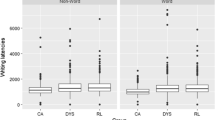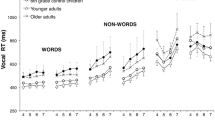Abstract
There is a growing body of evidence that children with dyslexia have problems not just in reading but in a range of skills including several unrelated to reading. In an attempt to compare the severity and incidence of deficits across these varied domains, children with dyslexia (mean ages 8, 12, and 16 years), and control groups of normally achieving children matched for IQ and for age or reading age, were tested on a range of primitive (basic) skills. The children with dyslexia performed significantly worse than the same-age controls on most tasks, and significantly worse even than the reading-age controls on phoneme segmentation, picture naming speed, word tachistoscopic word recognition, speeded bead threading and some balance tasks. The overall performance of the children with dyslexia is interpreted as showing less complete automatization than normal.
Similar content being viewed by others
References
Adams, M. J. 1990.Beginning to Read: Thinking and Learning about Print. Cambridge, MA: MIT Press.
Anderson, J. R. 1982. Acquisition of cognitive skill.Psychological Review 89:369–406.
Augur, J. 1985. Guidelines for teachers, parents and learners.In M. Snowling (ed.).Children’s Written Language Difficulties. Windsor: NFER Nelson.
Baddeley, A. D., Thomson, N., and Buchanan, M. 1975. Word length and the structure of short term memory.Journal of Verbal Learning and Verbal Behavior 14:575–89.
Bishop, D. 1985. Spelling ability in congenital dysarthria: Evidence against articulatory coding in translating between graphemes and phonemes.Cognitive Neuropsychology 2:229–51.
Bradley, L., and Bryant, P. E. 1983. Categorising sounds and learning to read: A causal connection.Nature 301:419–21.
Denckla, M. B., and Rudel, R. G. 1976. Rapid ‘Automatized’ Naming (R.A.N.). Dyslexia differentiated from other learning disabilities.Neuropsychologia 14:471–9.
Duffy, F. H., Denckla, M. B., Bartels, P. H., and Sandini, G. 1980. Dyslexia: Regional differences in brain electrical activity by topographic mapping.Annals of Neurology 7:412–20.
Fawcett, A. J., and Nicolson, R. I. 1994a. Motor skill and dyslexia.Journal of Motor Behavior, in press.
Fawcett, A. J., and Nicolson, R. I. 1994b. Phonological skill and dyslexia. Submitted.
Fawcett, A. J., and Nicolson, R. I. 1994c. Naming speed and dyslexia.Journal of Learning Disabilities, in press.
Fawcett, A. J., and Nicolson, R. I. 1992. Automatisation deficits in balance for dyslexic children.Peceptual and Motor Skills 75:507–29.
Fitts P. M., and Posner, M. I. 1967.Human Performance. Belmont, CA: Brooks Cole.
Frith, U. 1985. Beneath the surface of developmental dyslexia.In K. E. Patterson, J. C. Marshall, and M. Coltheart (eds.).Surface Dyslexia. London: Lawrence Erlbaum Associates.
Galaburda, A. M., Rosen, G. D., and Sherman, G. F. 1989. The neural origin of developmental dyslexia: Implications for medicine, neurology and cognition.In A.M. Galaburda (ed.).From Reading to Neurons. Cambridge, MA: MIT Press.
Gathercole, S. E., and Baddeley, A. D. 1990. Phonological memory deficits in language disordered children: Is there a causal connection?Journal of Memory and Language 29:336–60.
Haslum, M. N. 1989. Predictors of dyslexia.Irish Journal of Psychology 10:622–30.
Hynd, G. W., Semrud, M., Lorys, A. R., and Novey, E. S. 1990. Brain morphology in developmental dyslexia and attention deficit disorder/hyperactivity.Archives of Neurology 47:919–26.
Leonard, C. M., Voeller, K. K. S., Lombardino, L. J., Morris, M. K., Hynd, G. W., Alexander, A. W., Andersen, H. G., Garofalkis, M., Honeyman, J. C., Mao, J., Agee, O. F., and Staab, E. V. 1993. Anomalous cerebral structure in dyslexia revealed with magnetic resonance imaging.Archives of Neurology 50:461–69.
Livingstone, M. S., Rosen, G. D., Drislane, F. W., and Galaburda, A. M. 1991. Physiological and anatomical evidence for a magnocellular deficit in developmental dyslexia.Proceedings of the National Academy of Sciences of the USA 88:7943–47.
Lovegrove, W. J., Garzia, R. P., and Nicholson, S. B. 1990. Experimental evidence of a transient system deficit in specific reading disability.Journal of the American Optometric Association 61:137–46.
Lubs, H. A., Duara, R., Levin, B., Jallad, B., Lubs, M., Rabin, M., Kusch, A., and Gross-Glenn, K. 1991. Dyslexia subtypes: Genetics, Behaviour and Brain Imaging.In D. D. Duane and D. B. Gray (eds.).The Reading Brain: The Biological Basis of Dyslexia. Parkton, MD: York Press.
Miles, T. R. 1993.Dyslexia: The Pattern of Difficulties. 2nd Edition. London: Whurr.
Miles, T. R. 1983.Dyslexia: The Pattern of Difficulties. London: Granada.
Newell, A. 1973. You can’t play 20 questions with Nature and win: Comments on a symposium.In W. Chase (ed.).Visual Information Processing. London: Academic Press.
Nicolson, R. I. 1993. The Cognitive Operations Multimedia Battery.Internal report LRG 93/14. University of Sheffield.
Nicolson, R. I., and Fawcett, A. J. 1994. Reaction times and dyslexia.Quarterly Journal of Experimental Psychology. 47A:29–48.
Nicolson, R. I., and Fawcett, A. J. 1992. Toward the origins of dyslexia.In J. K. Kruschke (ed.).Proceedings of the Fourteenth Annual Conference of the Cognitive Science Society. Hillsdale, NJ: Lawrence Erlbaum Associates.
Nicolson, R. I., and Fawcett, A. J. 1990. Automaticity: A new framework for dyslexia research?Cognition 30:159–82.
Rosner, J., and Simon, D. P. 1971. The auditory analysis test: An initial report.Journal of Learning Disabilities 4:384–92.
Rudel, R. G. 1985. The definition of dyslexia: Language and motor deficits.In F. H. Duffy and N. Geschwind (eds.).Dyslexia: A Neuroscientific Approach to Clinical Evaluation. Boston: Little Brown.
Shiffrin, R. M., and Schneider, W. 1977. Controlled and automatic human information processing: II. Perceptual learning, automatic attending and general theory.Psychological Review 84:127–90.
Smith, S. D., Kimberling, W. J., Pennington, B. F., and Lubs, A. A. 1983. Specific reading disability: Identification of an inherited form through linkage analysis.Science 219:1345–7.
Snowling, M. J., Goulandris, N., Bowlby, M., and Howell, P. 1986. Segmentation and speech perception in relation to reading skill: A developmental analysis.Journal of Experimental Child Psychology 41:487–507.
Stanovich, K. E. 1988. The right and wrong places to look for the cognitive locus of reading disability.Annals of Dyslexia 38:154–77.
Stein, J. F. 1989. Visuospatial perception and reading problems.Irish Journal of Psychology 10:521–33.
Tallal, P. 1984. Temporal or phonetic processing deficit in dyslexia? That is the question.Applied Psycholinguistics 5:167–9.
Thomson, M. E. 1984.Developmental Dyslexia: Its Nature, Assessment and Remediation. London: Edward Arnold.
Vellutino, F. R. 1979.Dyslexia: Theory and Research. Cambridge, MA. MIT Press.
Wechsler, D. 1976.Wechsler Intelligence Scale for Children-Revised (WISC-R). Slough, NFER.
West, T. G. 1991.In the Mind’s Eye. New York: Prometheus.
Wolf, M. 1991. Naming speed and reading: The contribution of the cognitive neurosciences.Reading Research Quarterly 26:123–41.
Wolff, P. H., Michel, G. F., and Ovrut, M. 1990. Rate and timing precision of motor coordination in developmental dyslexia.Developmental Psychology 26:349–59.
Author information
Authors and Affiliations
Rights and permissions
About this article
Cite this article
Nicolson, R.I., Fawcett, A.J. Comparison of deficits in cognitive and motor skills among children with dyslexia. Annals of Dyslexia 44, 147–164 (1994). https://doi.org/10.1007/BF02648159
Issue Date:
DOI: https://doi.org/10.1007/BF02648159




